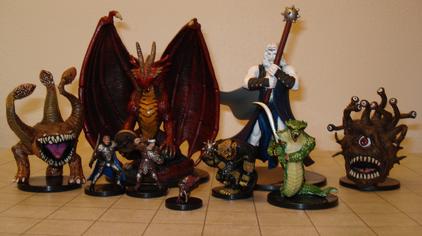 When we talk about “world building†on this site, we usually mean constructing a setting for a game from either the ground-up or modifying some aspect of an established game (Shadowrun, D&D,etc) that gives a new spin on it. This can be a daunting task, since even a small change in the interconnected fixtures of a setting threatens to knock the entire thing off balance. Still, the use of on-the-fly imagineering (Storyteller use of mental duck-tape and just plain lying) can help you keep the ship afloat. When you see a hitch in the setting you’ve created, you can simply explain it away with some bullsh*t and make a note to fix it later. The players are none the wiser and your position as ruler of the narrative is established.
When we talk about “world building†on this site, we usually mean constructing a setting for a game from either the ground-up or modifying some aspect of an established game (Shadowrun, D&D,etc) that gives a new spin on it. This can be a daunting task, since even a small change in the interconnected fixtures of a setting threatens to knock the entire thing off balance. Still, the use of on-the-fly imagineering (Storyteller use of mental duck-tape and just plain lying) can help you keep the ship afloat. When you see a hitch in the setting you’ve created, you can simply explain it away with some bullsh*t and make a note to fix it later. The players are none the wiser and your position as ruler of the narrative is established.
The problem I’ve been running into recently, however, is literal world building. Like, with miniatures and stuff. Asking your players to imagine an ominous warehouse or bustling marketplace is one thing, but it’s entirely different to illustrate the point with actual illustrations. Certain games (like Savage Rifts, the catalyst for this post) bake miniature use into the mechanics of the game. You can try to shorthand it, drawing crude lines on a piece of grid paper or using an erasable board, but you’re still on the hook for information that your players reasonably expect: Exact distances, height and material of objects (“is that a wooden barrel or a metal one?â€) and “wait… David, are those trees? So, there are just trees in the middle of the warehouse? Okay, just checking.â€
“How tall are the trees? Can I climb them?â€
In these situations, your players are honestly asking for info that their characters would get with a glance around their surroundings. The problem is this: Preparing for a game went from “Writing a Story for the players†to “Writing a story and Set Dressing for dramatic events.†It adds a huge chunk of time onto the process of preparing a game and can add a complexity that is great for your players but a huge pain to you. My advice? Triage and children’s toys.
First, figure out where major things are planned to happen and then keep a list of other spaces in your game. If the warehouse is where a hostage swap is taking place, then draw out the place before hand with detailed notes on the objects in the area. If there are other locations that the players may go to but you don’t expect things to get crazy (and therefor won’t necessitate miniature placement and such) then keep a list of those places in your notes with a brief description of the area. This will both allow you to have answers for your players while streamlining the storytelling process.
“Dave,†you ask, furiously scribbling into you notepad, “why would I keep such a list if I only plan for their to be combat in a few major scenes?†Great question! (So, so naive, but I love you anyways.) And the answer is in what I call Dave’s List of GM Constants: Miniatures Edition.
1: Keep children’s blocks handy, the little wooden ones you can get by the bucket from amazon. (Consider using our affiliate link!) This will allow you to build a setting quickly and painlessly.
2: The game will always take more work than you think. Keep lists of names, locations and strange facts of the area handy. In this case, minimize the panic of having to suddenly build an area by having adjectives next to the location. (Example: Subway- Desolate, Haunted. School- Cluttered, Dark.)
3: The Hamlet Rule: Your players will eventually act like lunatics and stab someone, or a difficult situation will spiral out-of-control until no one is left but two NPCs. (Stevens and Rubia, most likely.) Someone will be caught stealing from the mayor or insist on threatening the captain of the guard.  Get ready to clearly mark the exits for your players when something “pops off.â€
4: Someone will always start a fight in the tavern. Always.
So these are some of the things I’ve learned in my time having to design physical models for places my players will ruin or disregard. But what about you? Any tips or tricks for Game Masters delving into the world of miniatures? Any cheap workarounds for those gaming on a budget? Wanna hear about the time I constructed a forbidden underground temple with wooden blocks for my players, only to have my cat jump through it half way through the scene? Anybody want a slightly used cat? Let us know below.
Fandible.Com is now on Patreon! If you enjoy our weekly blog posts and actual play podcasts, please consider supporting us.



Don’t forget the Spanish Inquisition rule. Always expect the Spanish Inquisition. Somebody will do something nobody else expects. Be prepared to toss the entire adventure out the window and be ready to improvise on the fly.
I rarely pre-draw maps. I have an Idea in my head and if needs be I draw it. If I feel that they may return, take a quick pic on my phone.
Always remember when drawing maps, basic living facilities (ie kitchen, toilet, beds). They are so easilly forgotten in the face of the interesting features (science lab, gun turrets, bar, etc)
Re: Forgetting basic living facilities, I once drew a map for an office my players were to break into and they got so hung up on the fact that I forgot to include a bathroom that they built a whole mythos about why there wasn’t one, and how these people worked under bathroom-less conditions.
Not my proudest moment as a GM, but definitely one of those important lessons.
I’ve never run Savage Worlds with anything but theater of the mind. Do you feel that it adds a lot to the game to map it out?
Great question! I find that Savage Worlds (and Savage Rifts in particular) benefits from some use of miniatures since their use is baked into the mechanics. (Distances are measured in inches, for example.) While I don’t recommend every location be mapped out, I think that an erasable mat and some wooden blocks (or Legos, etc) should be used during climactic events where danger is prominent. This has two upsides:
1: Since things like objects and distances are on the board, the Game Master doesn’t have to remember everything about the situation. This allows you to do things like focus on your antagonists (if there are any in the scene) to pose better threats to the player characters.
2: Characters who are designed for mobility can actually feel rewarded for their build. I’m partial to fast characters myself (Monks in D&D, for instance) and it’s frustrating to play a Theater of the Mind game where your character’s talents are a footnote in a scene. (“Oh, yeah, you run faster than everybody but you all get to the boat at the same time.”) Illustrating the scene with miniatures allows for the Parkour specialist or Olympic runner to really shine. I ran a Rifts game recently where the PCs were running from a Bad Thing, and by using miniatures and a map the tension was much higher than if I had just described the setting.
Hope this helps! Keep the questions coming, I love breaking this stuff down.